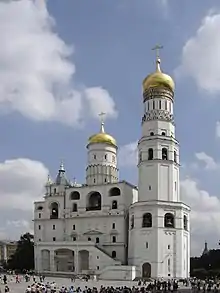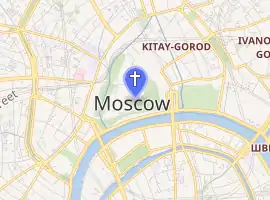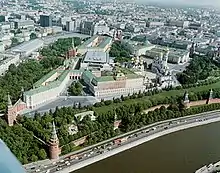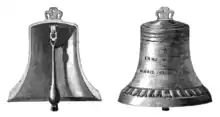Ivan the Great Bell Tower
The Ivan the Great Bell Tower (Russian: Колокольня Ивана Великого, Kolokol'nya Ivana Velikogo) is a church tower inside the Moscow Kremlin complex. With a total height of 81 metres (266 ft), it is the tallest tower and structure of Kremlin. It was built in 1508 on Cathedral Square for the three Russian Orthodox cathedrals, namely the Assumption (closest to the tower), the Archangel and the Annunciation, which do not have their own belfries. It serves as a part of Moscow Kremlin Museums.
| Ivan the Great Bell Tower | |
|---|---|
| Колокольня Ивана Великого | |
 Ivan the Great Bell Tower, with Assumption Belfry on the left | |

| |
| Location | Moscow |
| Country | Russia |
| Denomination | Russian Orthodox |
| Website | www.kreml.ru |
| Architecture | |
| Style | Russian |
| Completed | 1508 |
.jpg.webp)
History
From 1329, Moscow's first stone bell tower stood on this site, affiliated with the Church of St. Ivan of the Ladder-under-the Bell, hence the name "Ivan" in the title. This church was erected by Grand Duke Ivan Kalita, and was one of the first to be built in Moscow out of stone, rather than wood. During Grand Duke Ivan III’s major renovation of the Kremlin, he hired an Italian architect to replace this church. Construction was begun in 1505, the year of Ivan’s death, and was completed three years later under his son Vasily III. Vasilly also ordered that a new and unprecedentedly large tower be erected on the foundations of the old tower as a monument to honour his father.
The new bell tower, completed in 1508, originally had two belfries on different levels and a height of around 60 meters. Because of its height, the tower also served as an observation point against fires and the approach of enemies.
A new church, the Church of the Resurrection, was built next to the tower from 1531 to 1543, but already by the end of the 17th century it was used as bell choir stalls to supplement the hanging bells, rather than as a place of worship.
In 1600 on the orders of Boris Godunov the tower was raised to its present height. Until the building of the Cathedral of Christ the Saviour in 1883, it was the tallest building in old Moscow, and it was forbidden to put up any building in Moscow which was taller than the Bell Tower.
There's a popular yet disputable legend, that when Napoleon captured Moscow in 1812 after the Battle of Borodino, he heard that the cross on the central dome of the Annunciation Cathedral had been cast in solid gold, and immediately gave orders that it should be taken down. But he confused the cathedral with the Ivan the Great Bell Tower, which only had a gilded iron cross. This cross resisted all attempts of French equipment and engineers to remove it from the tower. It was only after a Russian peasant volunteered to climb up to the dome that the cross was lowered on a rope. When he went up to Napoleon seeking a reward, the latter had him shot out of hand as a traitor to his fatherland.[1] During the retreat Napoleon attempted to blow up the tower. The blast destroyed the former Church of the Resurrection, but the tower itself proved to be extremely stable and suffered only a few cracks in the foundation walls.
Ivan the Great Bell Tower adjoins the Assumption Belfry, which was built between 1523 and 1543 by the Italian immigrant architect Petrok Maly Fryazin (who converted to Orthodox Christianity and settled in Russia). It contains the Great Assumption Bell which was cast in the mid-19th century by Zavyalov, and it is the biggest of all the Kremlin bells. This ensemble contains 24 large bells.
Architecture
The Ivan the Great Bell Tower is an ensemble with three components. All of the buildings are made of brick, and are whitewashed in accord with the neighboring buildings of Cathedral Square. The tower itself consists of three octagonal drums, narrowing towards the top, and surmounted by a golden dome and seven-meter high cross. Each section has cut-out windows for the bells, and the upper third has a series of kokoshnik ornamentation (which marks the translation between the 1509 original and the 1600 addition).
Inside the tower a total of 329 steps long spiral staircase leads to the highest observation deck. The space on the ground floor of the base was once home to the Church of St. John Climacus and is cramped due to the walls being five meters thick. The former Church of the Resurrection, since the late 17th Century, only for the accommodation of bells, has a four-story rectangular base with large arched recesses for the bell choir stalls. A top drum decorated with a dome and cross. On the third floor of the building is a small chapel founded in the 19th century.
Bells
The Ivan the Great Bell Tower today contains 22 bells. Of these, 18 small bells hang in the base and in the middle of the bell tower. Of the four large bells, one is named the Uspenski Bell (Russian: Успенский колокол), and weighs 65.5 tons. It rings traditionally among the largest religious festivals such as Easter, and was made in the early 16th century.
Two large bells in the Assumption stalls are the 19.6-ton Reut (Russian: Реут) and the 16.6-ton Daily (Russian: Вседневный). The latter was cast by the same craftsman as the Tsar Cannon, Andrey Chokhov. The remaining large bell is the Sunday Bell (Russian: Воскресный), weighing 13 tons, which was cast in 1704 by Ivan Motorin, caster of the Tsar Bell.
Notes
- "The War with Napoleon". Vladimir A Lagutin. 2003. Archived from the original on 2011-08-12.
References
- Klein, Mina. The Kremlin: Citadel of History. MacMillan Publishing Company (1973). ISBN 0-02-750830-7
- Tropkin, Alexander. The Moscow Kremlin: history of Russia's unique monument. Publishing House "Russkaya Zhizn" (1980). ASIN: B0010XM7BQ
External links
| Wikimedia Commons has media related to Ivan the Great Bell Tower. |
- Official Home Page
- Ivan the Great Bell Tower Complex – museum site
| Records | ||
|---|---|---|
| Preceded by None |
Tallest Building in the Russian Empire 1721—1733 81.1 m |
Succeeded by Peter and Paul Cathedral |
| Preceded by None |
Tallest Building in the Tsardom of Russia 1547—1721 81.1 m |
Succeeded by None |
| Preceded by Troitskaya Tower |
Tallest Building in the Grand Duchy of Moscow 1508—1547 81.1 m |
Succeeded by None |
| Preceded by Troitskaya Tower |
Tallest Building in Moscow 1508—1952 81.1 m |
Succeeded by Kotelnicheskaya Embankment Building |

